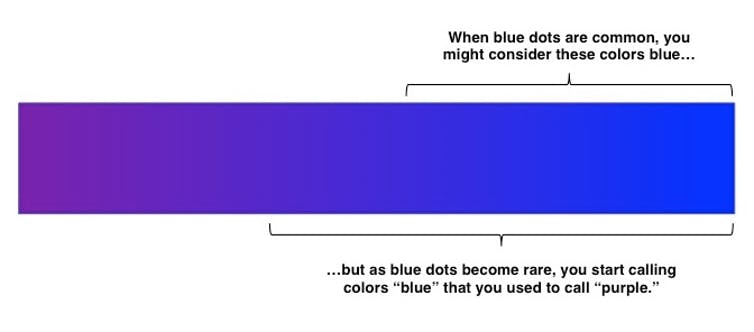When I hear of how Russia “attacked” the USA in the 2016 elections, and when I hear of verbal abuse being labeled a form of “violence”, and when I think a purple dot is blue because fewer blue dots have been appearing lately, then I think of “concept creep”. And then I recall how many of those of us leaving cults or other extreme fundamentalist churches were said to be experiencing the same disorder as returning soldiers with war experiences, “post traumatic stress disorder”.

Concepts that refer to the negative aspects of human experience and behavior have expanded their meanings so that they now encompass a much broader range of phenomena than before. This expansion takes “horizontal” and “vertical” forms: concepts extend outward to capture qualitatively new phenomena and downward to capture quantitatively less extreme phenomena. The concepts of abuse, bullying, trauma, mental disorder, addiction, and prejudice are examined to illustrate these historical changes. In each case, the concept’s boundary has stretched and its meaning has dilated. A variety of explanations for this pattern of “concept creep” are considered and its implications are explored. I contend that the expansion primarily reflects an ever-increasing sensitivity to harm, reflecting a liberal moral agenda. Its implications are ambivalent, however. Although conceptual change is inevitable and often well motivated, concept creep runs the risk of pathologizing everyday experience and encouraging a sense of virtuous but impotent victimhood.
- Haslam, Nick. 2016. “Concept Creep: Psychology’s Expanding Concepts of Harm and Pathology.” Psychological Inquiry 27 (1): 1–17. https://doi.org/10.1080/1047840X.2016.1082418.
—
Why do some social problems seem so intractable? In a series of experiments, we show that people often respond to decreases in the prevalence of a stimulus by expanding their concept of it. When blue dots became rare, participants began to see purple dots as blue; when threatening faces became rare, participants began to see neutral faces as threatening; and when unethical requests became rare, participants began to see innocuous requests as unethical. This “prevalence-induced concept change” occurred even when participants were forewarned about it and even when they were instructed and paid to resist it. Social problems may seem intractable in part because reductions in their prevalence lead people to see more of them.
- Levari, David E., Daniel T. Gilbert, Timothy D. Wilson, Beau Sievers, David M. Amodio, and Thalia Wheatley. 2018. “Prevalence-Induced Concept Change in Human Judgment.” Science 360 (6396): 1465–67. https://doi.org/10.1126/science.aap8731.
